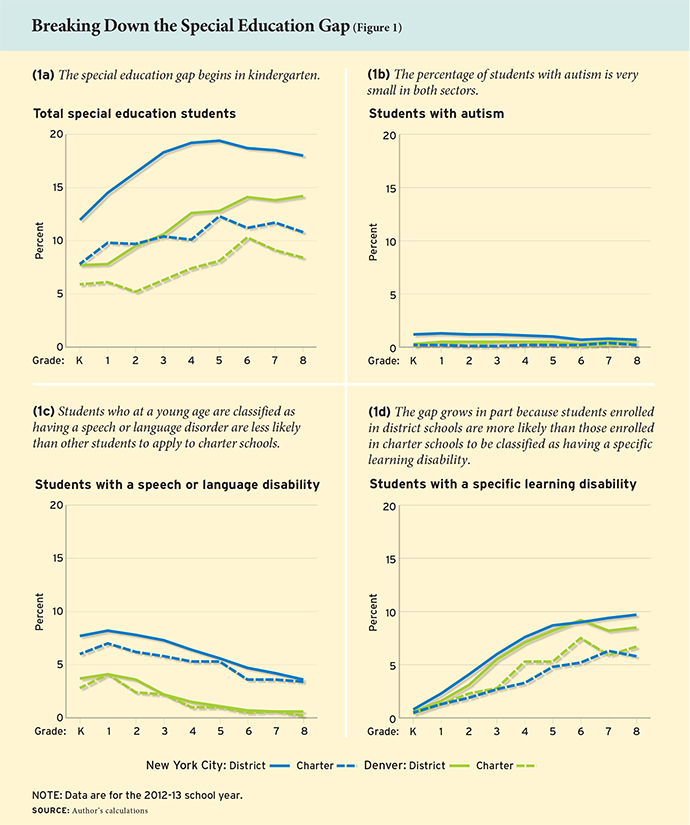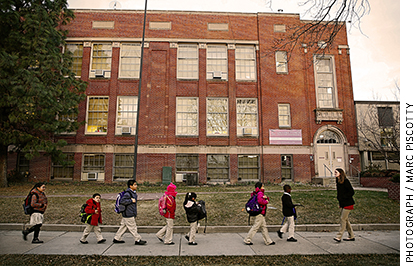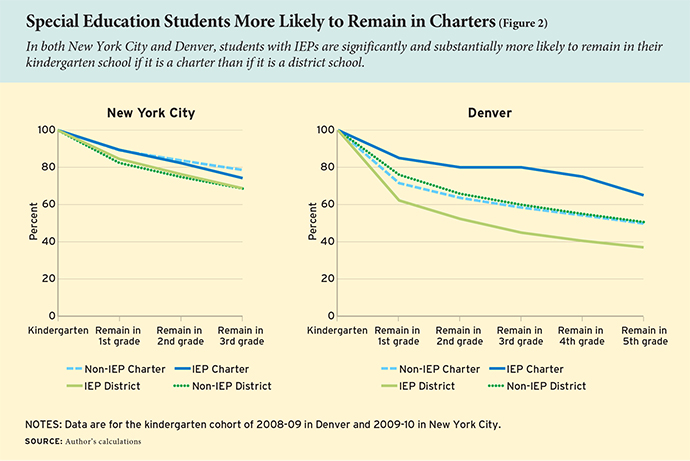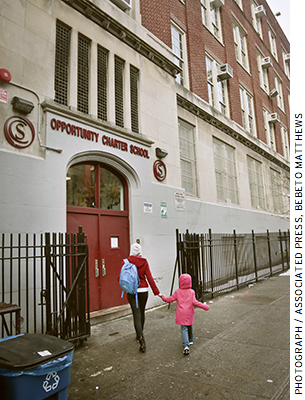As public schools, charter schools are legally required to educate all students regardless of the difficulties they bring with them into the classroom. Nonetheless, many are concerned that the charter sector fails to educate all comers. Charter schools are often criticized for not enrolling similar proportions of students with disabilities as are enrolled in schools operated by the surrounding district. For instance, a recent report by the Government Accountability Office (GAO) found wide gaps between the percentages of students enrolled in special education in charter schools and in surrounding district schools. In New York City, Schools Chancellor Carmen Fariña recently implied that the city’s charter schools remove low-performing students in order to increase their aggregate test scores. Last year the New York Times published an op-ed arguing that the seeming success of charter schools in Harlem is driven by their willingness to push out students with disabilities, and that such “charter school refugees” drain district schools of resources.
 Only anecdotal evidence has been offered in support of the claim that charter schools systematically remove students with disabilities, and little rigorous research has considered the underlying causes of the difference between the percentage of charter-school students and district-school students enrolled in special education, the so-called “special education gap.” But if we are to adopt sound policies to address such a gap, we need to understand its underlying causes.
Only anecdotal evidence has been offered in support of the claim that charter schools systematically remove students with disabilities, and little rigorous research has considered the underlying causes of the difference between the percentage of charter-school students and district-school students enrolled in special education, the so-called “special education gap.” But if we are to adopt sound policies to address such a gap, we need to understand its underlying causes.
In this study, I examine data on all elementary-school students in certain years in New York City and Denver, Colorado, to estimate the relative importance of various factors that appear to be contributing to a special education gap. My findings suggest that the gap, though real, is not as disturbing as it might seem. Two key drivers of the gap are differences in rates of students being classified as having a Specific Learning Disability (SLD) and the rates at which students who do not have disabilities move from one sector to the other. Neither factor indicates that charter schools are driving special education students away from their doors. Further, the size of the gap is determined largely by differences among students with mild rather than severe learning difficulties.
Both New York City and Denver are considered leaders in the charter school movement. Each city has experienced rapid expansion of the charter school sector in recent years. While the evidence for the effectiveness of charter schools nationwide is mixed, research has found that the charter schools in these cities are on average more effective than district schools in raising student test scores.
In my prior work on middle schools, I found that the special education gap in Denver was almost exclusively caused by differences in the rates at which students with disabilities and students without disabilities apply to charter schools in gateway grades (that is, when all students are entering school initially or graduating from elementary to middle school, for example). In this article, I identify key factors that contribute to the gap during the elementary-school years.
Although the data are richer for Denver than for New York City, my essential findings from the two cities are remarkably similar. In both, the relatively low enrollment of students with severe disabilities in charter schools accounts for very little of the gap, as there are very few of these students in either school sector. Instead, the special education gap begins in kindergarten, when students classified at a young age as having a speech or language disorder are less likely than other students to apply to charter schools. It grows in part because students enrolled in district elementary schools are considerably more likely to be classified as having an SLD than those enrolled in charter elementary schools. Also, students with disabilities are less likely than students without disabilities to enter charters in non-gateway grades.
Data
Longitudinal student-level data were provided by the departments of education in New York City and Denver. The New York City data cover the school years 2009‒10 through 2012‒13. The Denver data include 2008‒09 through 2013‒14. Each data set includes information for the universe of students attending a charter or district school in the respective city.
For each city, the relevant data identify the school in which the student was enrolled that year and indicate whether the student has an Individualized Education Program (IEP), which qualifies him or her for special education services. The data also include the student’s particular disability addressed by the IEP. Unique student identifiers allow me to map student movement and classification changes each year.
In New York City, students apply to each individual charter school directly. Unfortunately, as a result, I do not have information regarding whether students applied to (but did not enroll in) charter schools in New York City.
The school choice process is more centralized in Denver. Each year, students have the opportunity to state a preference for up to five schools—including charter and district schools. Most parents of students in gateway grades fill out the forms necessary to state a school preference. Thus, in Denver, for school year 2012–13, the data set also includes information about student preferences for schools according to the city’s school-choice policy.

The Gap in the Two Cities
As critics have claimed, there is in fact a special education gap in the two cities. In Denver, in 2012‒13, the percentage of special-education kindergarten students was 1.8 points higher in district schools than in charters. In grade 5 that difference was 4.7 percentage points. During the same school year in New York City, the differences at the same two grade levels were about 4 and 7 percentage points, respectively (see Figure 1a).
The paucity of severely disabled students in charter schools is often highlighted in public commentary on the special education gap. It is true that district schools enroll significantly larger percentages of students with relatively severe disability classifications than do charters. As shown in Figure 1b, the share of students with autism is 0.2 percentage points smaller in charters than in district schools in Denver and 1 percentage point smaller in New York City. Results for traumatic brain injury are similar. These differences do not contribute substantially to the overall special-education gap, however, as the percentage of students with severe disabilities is very small in both sectors.
Students who are identified as having speech and language disabilities play a much larger role in the gap story, especially among students in kindergarten (see Figure 1c). About 41 percent of the gap in kindergarten in New York City and 50 percent of the kindergarten gap in Denver is caused by the differential presence of this type of student. But few students classified in this manner early on continue to be identified as in need of special services. As a result, the gap between charters and districts for students with this type of disability declines to the point of insignificance in later grades.
I suspect that the kindergarten gap is driven primarily by the fact that school districts often provide speech and language services to students in need of them prior to entry into kindergarten, and the parents of such students are reluctant to switch to a charter school, thereby interrupting the continuation of these services. As a result, parental choices contribute to the creation of a special education gap at the very beginning of formal schooling.
The opposite situation prevails for the category of students identified as having an SLD (see Figure 1d). The growth in the special education gap after kindergarten in both cities is driven almost entirely by changes in the percentage of this group of students. Note that only a small percentage in either sector are classified as SLD students in kindergarten. Rather, the percentage increases rapidly from one year to the next as students pass through the elementary grades. But the growth of SLD enrollments is more rapid in district schools than in charters.
Those who focus on more “severe” classifications are ignoring the elephant in the room. SLD is among the mildest special-education classifications. It is also the most subjectively diagnosed. For example, prior research by Donald MacMillan and Gary Siperstein has indicated that SLD is likely overdiagnosed in district schools.
Charter School Application and Enrollment
Thus far I have discussed the type of disability that contributes the most to the special education gap between district and charter schools. No less important are the main factors that generate the gap: students entering charters may differ from those entering district schools (with respect to their special education needs), and students leaving charters may differ from those leaving district schools. Another factor is classification rates. District and charter schools may differ in their readiness to classify a student as having a disability. This is more likely in the case of mild disabilities, such as speech and language disabilities and SLD. The data allow me to look into each of these potential underlying causes of the gap.

Figure 1 provides some evidence regarding the types of students who enter into a charter school in kindergarten. Since students who apply to charter schools are assigned to enrollment randomly, we can have some confidence that the characteristics of those who enter charter schools in kindergarten mimic those of the students who apply.
Even if the lotteries are truly random, however, it is possible that students with disabilities who win a spot in a charter school are less likely to actually enroll. Unfortunately, because the results of enrollment lotteries are not centrally collected in New York City, the data set limits the ability to look at the characteristics of charter school applicants there. However, a unique feature of the Denver data set allows one to observe not only who enrolls in a charter school, but who applies to attend one through the city’s universal choice system.
The Denver data show that students with disabilities are somewhat less likely to apply to attend a charter than are students without disabilities. In kindergarten, 5.6 percent of students who listed at least one charter school as one of their five preferences had an IEP, while 7.8 percent of students who did not list a preference for a charter school had an IEP. These numbers are similar to those for actual percentages of students with IEPs enrolled in charter and district schools reported in Figure 1a.
Next, I look at students who leave their schools. If the special education gap is largely driven by charter schools systematically removing students with disabilities, we should expect that students with disabilities would be more likely to exit their school if it is a charter than if it is a district school. In New York City and Denver, this is not the case.
To examine this issue, I restrict each data set to include only students who were enrolled in kindergarten in the first observed year (2008‒09 in Denver, 2009‒10 in New York City). Figures 2a and 2b describe the percentage of such students who remain in their original elementary school after a given number of years according to their IEP status in kindergarten. (Results are similar for students who are observed with an IEP at any point in the time period considered.)

The results are again remarkably similar in the two city school systems. In both cities, students with existing IEPs are significantly and substantially more likely to remain in their kindergarten school if it is a charter than if it is a district school. In Denver, four years after entry in kindergarten, 65 percent of students with IEPs remain in their original charter school, compared to 37 percent of students who began in a district school. In New York City, four years after entry in kindergarten, 74 percent of students with IEPs remain in their original charter school, compared to 69 percent of students who began in a district school.
For the kindergarten cohorts of 2008‒09 in Denver and 2009‒10 in NYC, the impact of students with IEPs moving across sectors or out of the city school system is to decrease the special education gap in both cities. That’s because in both New York and Denver more students with IEPs enter charter schools in grades after kindergarten than exit them.
Of course, we cannot observe the reasons that students exit, and thus I cannot say just how numerous are the incidences of charters (or district schools) counseling out students with disabilities. Nevertheless, the results strongly suggest that the special education gap is not due primarily to students with disabilities exiting the charter sector.
The Classification Factor
As mentioned, the special education gap in elementary schools originates because students with disabilities (especially those related to speech and language) are less likely to enter charter schools in kindergarten. In both cities (especially in Denver), the special education gap grows as students proceed from kindergarten through the 5th grade, and charters classify fewer students as SLD than do district schools.
The gap will grow or contract if students in either sector either receive a new IEP or have their IEP status declassified. A student with an IEP could exit the city’s system entirely or move from one sector to the other.

For both cities, I again restrict the analysis to students who were enrolled in kindergarten in the first observed year. For each year after initial enrollment, I map student classifications and movements within and out of the city’s school system. I then quantify the influence of each factor on the change in the percentage of students who have an IEP within a sector. That is, the analysis quantifies how the percentage of students with IEPs in charter schools increased between 2008–09 and 2009–10 due to students being newly classified into special education, to students with IEPs exiting the sector, and so on.
In Denver, new IEPs increased the percentage of students with IEPs in district schools by 10.4 percentage points and the percentage of students with IEPs in the charter sector by 7.8 percentage points, for an increase in the gap of 2.6 points. In New York, the corresponding figures were 8.9 and 8.3, respectively, which increased the gap by less than 1 point (.57).
In both cities, students enrolled in charter schools are significantly less likely (and in Denver, substantially less likely) to be newly classified as having an IEP than are students in district schools. In both cities, this difference is driven nearly entirely by the greater probability that a student is classified as SLD in the district-school sector. It is not certain whether students in the district sector are more likely to become in need of special education or whether district procedures are designed to identify more readily that a student is in need of these services. One suspects that both factors are at work.
Mobility of students with IEPs obviously influences the percentage of students enrolled in special education. When a student with an IEP enters into a school, either from outside of the system or from the other sector, he has an impact on the receiving sector’s percentage of students with IEPs. The exits and entries of students without IEPs also influence the percentage of students who have IEPs within each sector by changing the total number of students in that sector (the denominator of the calculation), even though it has no impact on the number of students with IEPs (the numerator).
Student mobility increases the special education gap largely because of the movement of students who do not have IEPs. As we saw previously, elementary-school students without IEPs are more likely to enter charter schools in non-gateway grades than are students with IEPs. Each student without an IEP who enters a charter school decreases the percentage of students in the charter sector with an IEP.
This influence of student mobility on the special education gap is driven in part by the difference in size of the two sectors. Of course, the percentage of students with IEPs in a sector is calculated by dividing the number of students with IEPs by the total number of students in the sector. There are far more students enrolled in district schools than are enrolled in charter schools. Consequently, the movement of a single student from one sector to another has a much larger impact on the proportion of students with IEPs enrolled in charter schools than on the proportion of students with IEPs enrolled in district schools. This simple computational phenomenon tends to exacerbate the observed special-education gap.
For instance, consider the impact of a student who is not in special education moving from the district sector to the charter sector in Denver. During the time period analyzed, this category included 405 students. The impact of the movement of these students was a decrease in the proportion of students in special education in the charter sector of 5.1 percentage points. The influence of these same students on the district-school sector was an increase in the proportion of students classified as special education by only 0.9 percentage points. Thus, the overall impact of the movement of these students was to increase the special education gap by 4.2 percentage points.
Implications for Policy
The special education gap begins primarily because students classified as having a speech or language disorder are less likely than regular-enrollment students to apply. It grows in part because students enrolled in district schools are considerably more likely to be classified as having a specific learning disability in early elementary grades than are students enrolled in charter schools, and also because students without disabilities are more likely to enter charters in non-gateway grades than are students with disabilities. This result is remarkably similar across both cities. The overall special-education gap does not appear to be heavily influenced by relatively low enrollment of students with severe disabilities in charter schools.
That classification differences for SLD in later grades are a major driver of the gap is especially interesting. Prior research suggests that SLD is overidentified in district schools and that classifications are heavily influenced by student academic performance. These findings appear to open the door to the possibility that some portion of students who are not classified as disabled in charter schools would have been so classified had they instead attended a district school. Unfortunately, the analyses in this paper are not capable of identifying whether the differences in classifications are due to the type of student who attends each sector, or if there is something about charter schooling itself that reduces the probability that a student is newly classified as having a disability.
The conventional argument that charters enroll relatively few students with disabilities because they “counsel out” special needs students after they enroll is inconsistent with the enrollment data. In fact, students with disabilities are less likely to exit charter elementary schools than they are to exit district schools. More students with IEPs enter charter schools in non-gateway grades than exit them. Of course, I do not mean to imply that no student has been inappropriately removed by a charter school because of his disability. But the fact that students with special needs in charter schools are less mobile than those in district schools suggests that such incidences are not widespread. Policies meant to address the special education gap that focus on the movement of students with IEPs are unlikely to be productive.
One area where policymakers could influence the special education gap is by providing charters with resources and incentives to better recruit students with disabilities (particularly those with a speech or language impairment) to apply in kindergarten. Interestingly, the initial special-education gap in kindergarten is much smaller in Denver than it is in New York City. Though further research is required to make any firm judgments, the most likely reason for this difference is Denver’s use of a universal enrollment system in which charter schools participate compared to the practice in New York City, where parents apply to individual charter schools.
Marcus A. Winters is senior fellow at the Manhattan Institute and assistant professor in the College of Education at the University of Colorado Colorado Springs. The New York City results described were reported in a paper jointly released by the Center on Reinventing Public Education (CRPE) and the Manhattan Institute. The Denver results first appeared in a report for CRPE. The Denver results additionally appear in the May 2015 issue of Educational Researcher.
This article appeared in the Fall 2015 issue of Education Next. Suggested citation format:
Winters, M.A. (2015). The Myth About the Special Education Gap: Charter enrollments driven by parental choices, not discriminatory policies. Education Next, 15(4), 34-41.


